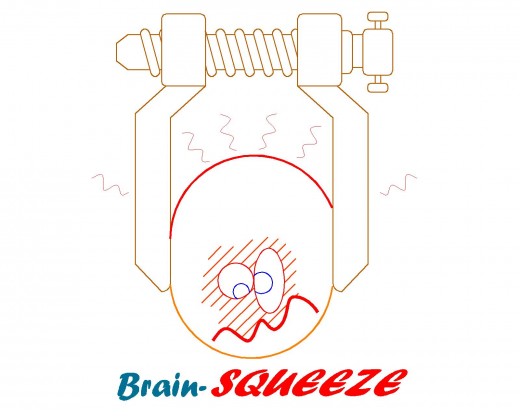The 25 Cent Psychologist

Behind The Curtain
The brain works together to accomplish tasks on a global scale. All those global outcomes are a composite result of all the little entities contained within that 3 & 1/2 pounds of grey gelatinous mass taking up space between your left and right earlobe. These components can work independently or in conjunction with other entities as needed to accomplish subordinate tasks and then compile their results to accomplish tasks of a progressively larger hierarchy. Neurons working with other neurons in increasingly complex networks of bifurcating transmission lines, forming registers where intermediate results are processed before being sent up the chain to initiate more responses of an increasingly complex scale.
The brain regulates, dispatches, synthesizes, operates a switching center, regulates input and output from an impossibly complicated network of connections on a platform that runs on a parallel processing system. I venture to say that there are more knobs, buttons, and levers to turn, push, and pull that would task a team of engineers. It's busier than mission control at time of launch. And it does all this amazing processing without your conscious awareness or effort. That in itself is incredible enough to leave you open-mouthed and glassy-eyed.
Under the hood
I suspect a mechanic would make a terrible neurosurgeon, as the neurosurgeon would be an equally pathetic mechanic. But there is an anolgy I suppose between a mechanic with his head under the hood and a neurosurgeon. The element of mystery that begs the question, What happens under the hood and what do all those strange parts do?
I won't belabor you with a protracted discussion of what goes on under the hood when it comes to that collection of organic tissue that houses what we call the mind. That would be a pretentious exercise on my part. Somehow the brain provides a tangible framework with which intangible entities reside, where cognition and thought mysteriously occupy like ghostly apparitions haunting a house.
I won't attempt an exhaustive discussion of every component however I can't avoid rehashing some basic operational guidelines if we're to make any useful observations or conclusions.
There's no small measure of irony here that although we may possess only a nebulous conceptual view of the mind, we are still able to utilize it. How do all these mental, cellular, and physiological functions operate on some complex inner level while the conscious mind can only resort to conjecture and logic in an attempt to discover its own make up
All of this reminds me of a scene from the Wizard of Oz when they pull back the curtain to unveil the levers and controls. While thankful for MRI and all the other devices that allow us to look behind the curtain, to peer inside the inner workings as never before. Despite all our technical advances that have ushered this new era of analytical acuity, we still resemble someone peeking through the keyhole into a darkened room than the scientists we presume ourselves to be.
The brain is an amalgation of disparate bits & pieces working together to accomplsh tasks on a global scale. It has a heirarchy of structure and operations it follows, operating on a parallel processing paradigm. You have two cerebral halves that work independently yet also collaorate through mutual structures. There is an extensive sensory bio feedback system in place. Switching and routing of signals takes place in the thalamus across a vast and extensive labyrinth of interconnectivity based on a neural network comprised of neurons and adjacent dendrites that fire across open synapses via neurotransmitters to modulate the process. The brain operates on a chemical and electrical triggering system. To describe it as an intricate system that defies description would be an understatement.
Has anybody Seen The Cat?
Have you ever asked yourself, why did I do that? And in all seriousness, wonder why you did? Why is change so difficult?
I think part of the reason these apparent anomolies exist is because we operate by habit. The subconscious runs in the bacground behind the scene dictating so many facets of our life we take for granted, unaware of the vast machinery operating below the threshhold of awareness. It's so efficient we don't even realize the system running beneath the surface.
In fact, I wonder how much the subconscious and the conscious mind may even be aware of each other, which may pit them in an internal state of conflict. Imagine two sets of hands on the steering wheel, for the sake of illustration. Some of the time these competing systems are inclined to work together and sometimes in direct conflcit, as opposing antagonists of sorts.
Our psyche operates on levels we may, for the sake of convenience, refer to as programs. On the physical level, the cerebellum has memorized series of complicated actions that otherwise would be uncoordinated. Walking is an extremely complex series of momvements and signals between sensors in the body and their receptors in the mind; we take in input from the semicircualr canals for balance, objects we preceive from the eyes to include peripheral movement, depth perception from the parallax arrangement of our eyes which takes in similar streams of data and compares and contrasts the inputs to make a series of intuitive guesses.
Making a layup is another example of a series of complex movements that had to be learned, coordinated and choerographed, then recorded in our muscle memory and stored withn the cerebellum; before being synchronized, organized and played back when needed.
The cerebellum stores complicated series of movements and responses that once learned, do not have to be learned again. Modified, adjusted, etc. But not re-learned. Imagine if you had to re-learn how to walk every morning or ride a bike or play the piano or play a video game. Imagine the chaos of daily activities that would otherwise be consumed by rote mechanics. This is illistrated by a stroke victim that suffers brain some extent of internal damage, gets their 'hard drive' erased, and is forced to re-learn this extremely complicated series of orchestrated movements all over again, via physical therapy.
Back to the brain, in particular the conscious and subconscious mind.
So we have these two separate entities that govern our behavior residing within the same biological structure. But each behaves differently. The conscious component contained primarily in the forebrain makes evaluations and choices based on a separate series of criteria that the subconscious operates by. The subconscious uses programmed sets of movement to operate on a machine or animal level. It monitors, compares, makes evaluations and then effects changes without conscious thought. There is no cognitive awareness or cooperation unless certain parameters or constraints are invoked. Not always true but generically. The subconscious operates on certain pre-defined paramaters encoded in our DNA. But it is also a learning machine and is capable of altering or even re-writing its own hardware when needed. When it 'learns' a new repsonse and behavior based on input and reactions, it stores these programs and re-uses them on as needed basis. Associations are made and stored in the amygdala. "I like this. I don't like this. This makes me feel this way. This stimuli evokes an entirely different set of feelings." The amydala is that part of the brain that associates banana pudding as good and boiled cabbage as an unpalatable mess to be regurgitated. It assoicates homework or chores as something we dread while attributing pleasant thoughts to a game of full court basketball or going to the movies. It makes the single guy smile back when a pretty girl batts smiles at him or a married man recoil when his mother-in-law comes to visit. These associations carry more weight than we realize in our day to day functions of life.
The subconscious does not involve the conscious mind. We don't have to 'think' about monitoring and adjusting our heart rate and blood pressure, carbon dioxide level, circadian rythym, and the myriad of complicated biological process that maintain homeostasis. If all these processes had to rely on conscious thought for evaluation and effecting responses based on constantly changing criteria, much of our daily existence would be occupied and unavailable for other ventures, less critical pursuits like study, relaxation, conversation, etc.
I can't play basketball now because I have to think about making enzymes, regulating my blood pressure and blood sugar, oxygenating my blood, etc. I can't play chess or listen to music or watch TV because if I don't allocate all these mental resources to monitor and react to stimuli and other critical processes, I will die.
When you understand the similarities and differences between the conscious and subconscious, then you are just beginning to grasp just why change is so hard.
And now you know why you absent-mindedly put the cat in the refrigerator.
Half A Mind...
The premise seems simple enough. We fail. We evaluate why we failed and then we effect the appropriate changes to ensure a higher probablity of success.
So why do we fail again, when we knew better?
Failure seems to be a consistent pattern in humanity. So is defeat and depression. It seems it's easy to become accustomed to failure. So we wallow in our increasingly vicious cycle of defeat and despair until we have trained ourselves to become despondent, to accept our miserable state of fialure as inevitable and unalterable. Perhaps it's a form of self-defeating classical conditioning that would have made Pavlov and his dogs envious of our success at the art, or is it science, of failure.
We promise ourselves we will change, and then we fail again. We fail in pretty much the same predictable pattern of failure, as we did previously. We become adept at lying to ourselves, that we can change, only to end in the same deplorable and at this point predicatable state of failure as the last time.
But why is that?
We have 'learned' how to fail and although not desireable, this state of failure has somehow simulataneously becomes both deplorable and comfortable. And predictable. My theory is that part of our brain resists change, even productive change; which is why, I perceive, that it perceives said change to be a threat to our our preferred internal state of constancy, which i will relate to as homeostasis on a mental level.
In short, part of our mind serves to resist change as a means of counterbalance. This lends itself to a certain measure of survivability, as opposed to elimination by idiocy. We internally resist change, to borrow a couple of concepts from the electrical theory aspect, impedence and reluctance. Part of our mind occupies a state of reluctance and therefore impedes change. We, like electricity, take the path of least resistance that brings us back to the ground state of fialure. Gravity: pulling us down, holding us down. Man, as we know, is a creature of habit, even 'bad' habits that are conducive to failure.
Much or our learned process of failure has been self taught by the time we're in elementary school. Homework is assigned. We train ourselves to associate this assignment with a predicatble amount of dread. And when we dread something, at that state it is pretty much a given that we will predictably dread a task. It's pretty much a given that we will only reinforce this dread with each successive assignment prescribed. The subconscious mind stores this association in the amygdala, and we have 'learned' to fail. It's a form of mental entropy.
Removing the negative association seems to be a positive first step toward learning how to succeed instead of reinforcing habits of failure. But the mind and the body, being a creature of habit, so you will encounter a stubborn state of reluctance to change that must be overcome. For some, we accomplish this through a new series where we determine we will persevere until new habits are allowed to re-write the old.
Let me illustrate it this way;
The volitional part of the conscious mind, from the forebrain, intitates a referendum. "You have a big test on Monday and you are going to study". This sets in motion an entire range of cerebreal activity that sends signals through the network; connections are being made and neurons are firing. We get a little rush of adenaline pumping through the system as we internally visulaize in the occupital cortex the feeling of gratification from the A+ we know we are goig to get. The appropriate switching takes place in the thalamus and everything is going fine until...we get to the amygdala. The amygdala is a glum little fellow that reminds us, "Hold everything, guys! Study = dread. We don't like to study". And suddenly everything comes to a screeching halt. The whole communication network gets clogged with little alarms going off and buzzers buzzing inside our head. The dread signals shuts down the rest of the brain, which automatically kicks in the 'good intentions' circuit which kicks in the 'procrastination' response and next thing you know, we're watching TV or playing a video game while the conscious mind is screaming, "You guys are gonna' wish you'd listend to me come Monday morning"!
Next week we do it all over again. Then we go into remorse mode as we recriminate on why we always do that to ourselves.
It becomes a simple step-by-step process until we re-learn our new corrective behavior.
For some of us, we must be pushed, threatened, beaten, scorned, or otherwise cajoled to function.
It is easy to change our conscious thought and state of mind; it is another thing entirely to change our inner state of mind on the subconscious level. These two are not prone to communicate.
By this time your head is about to explode so let me throw in a brief intermission before attempting some kind of conclusion here.
Half a mind???
Someone says, "I've got half a mind to...."
Which makes me ask myself, "Where's the other half?"
We say, "I'm going to change"! And the subconscious mind interrupts and says, "No one told me"!
That's what we're up against. So remember, when you decide you should change your behavior, the subconscious mind is plotting to thwart you scheme. Maybe you should consult uour subconscious if you're really serious about this change thing?
These stubborn vestigial states of behavior still influence more of our inner thought process than we realize because these the lower levels of the subconscious aren't as visible as those residing on the upper levels of the cognitive elevator.
Some of us may even have to be forced to undergo a catharsis of sorts before we are prepared to begin the slow and sometimes painful process of change.
In conclusion, I should point out that I really haven't told you anything you probably didn't already know. Hopefully, I was able to frame it in a context that will bridge the gap between real change and the game of charades we usually play with ourselves.
I'm going to change...this time!!!
I think I hear my subconscious mind snickering in the background?
© 2012 Jim Henderson








